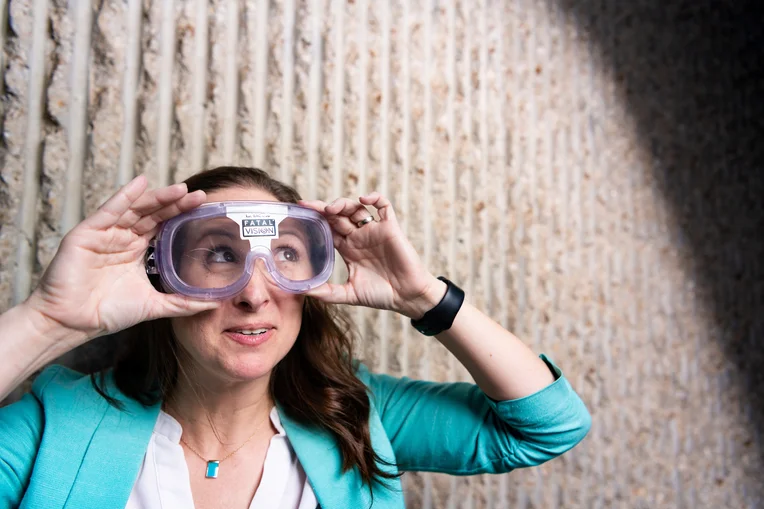Quest Magazine Dr. Sunnin Keosybounheuang
"I never imagined getting a master’s or doctoral degree … I was a teacher."

Dr. Sunnin Keosybounheuang went from a middle school health education teacher to a stay at home mom before deciding to pursue graduate degrees. She now serves as graduate faculty within the Health, Physical Education, and Recreation Department at Emporia State University.
Sunnin Keosybounheuang left her undergraduate career at Emporia State University with a Bachelor of Science in Elementary Education. Her career path was clear: teach. She served as a middle school health teacher for 10 years where she hosted many ESU methods and student teachers.
Although she loved her job as a middle school teacher, her family, she decided, took precedence. She decided to stay home and raise her children.
“I enjoyed my job as a middle school health education teacher. It was hard for me to leave. When I go back into the public schools to observe, I feel the urge to return and work with middle school students.They have a special place in my heart,” she said. “Leaving to be with my children until they went into kindergarten was as close as I was going to get to having a career and be at home with my children while they were young. I would not trade my choice.”
Not only was her family her first priority, but she also felt unequipped to move forward in her education.
“I have looked up to those who have gone on in their education, I just never thought I was one of those people that possessed the ability, grit and intelligence to move forward in my education,” Keosybounheuang explained.
While acting as a stay-at-home-mom, Keosybounheuang took odd jobs here and there to help pay for expenses. From photography to selling jewelry as a representative of Premier Designs, Keosybounheuang did what she needed to to make ends meet during her time at home. Although the interest in graduate school was there, she just never saw herself pursuing another degree.
“I never imagined getting a master's or doctoral degree. After graduating with my bachelor's degree, I was so excited to go out and teach. I thought only researchers went further in school, and I didn't put myself in that category. I was a teacher,” said Keosybounheuang.
Once her children were in school, Keosybounheuang began to consider her options. With a bit of persuasion, Keosybounheuang decided to take the daunting next step of applying to graduate school.
“With the encouragement of my friends, colleagues and my family, I took on the challenge of graduate school for a variety of reasons: To see if I could do it; to be a role model for my children; and to advance my current position. Balancing a full-time teaching job, an active family, finances, my health and maintaining my sanity were all challenges during the 5 1/2 year journey.
“My children would see me studying in the evenings. At first, I was sad because this would be the scene far too often,” she said. “However, one night, they sat down with me with their books and notebooks and asked if they could do their homework with me. That was how they told me it was okay, that they were proud of me and that they understood and respected my education.”
Although there was a lot to juggle, Keosybounheuang was able to work as a graduate assistant, which provided pay as well as experience teaching. While her children were in preschool, she taught a general education class and took online classes to complete the degree.
She completed her master’s the same year her youngest child started kindergarten.
After finishing the degree, Keosybounheuang accepted an instructor position.
“I felt I had a lot to offer my students with my practical experience, however, I wanted to go the next step and earn my doctoral degree,” she said.
Keosybounheuang enrolled in a doctoral program through Northcentral University in Arizona. The program was entirely online and accelerated, which meant fast-paced, eight-week courses, and also required completion of a dissertation. Keosybounheuang focused her research on the relationship between the inclusion of health education in 9th and 10th grade schools and performance on standardized mathematics assessments for 11th grade students in Kansas schools.
“My struggles were similar to most I would imagine — working a full-time job, balancing family time, finances and keeping my sanity. I had good support with family, colleagues and friends. The biggest struggle was staying the course and seeing the light at the end of the tunnel. I would get so overwhelmed and want to quit. Without my husband, colleagues and friends encouraging me to keep going, I might not have made it!”
Keosybounheuang made it through, and although the path was not an easy one, acknowledges a myriad of opportunities that opened up as a result of her endurance.
“My degrees allowed me to stay in higher education and continue doing what I enjoy — preparing future teachers. I enjoy being creative and planning interactive lessons for K-12 health classes. I presented as a public school teacher but now I have more opportunities to present and share what I do in class and how I prepare my students to be teachers,” she said. “I have had the exposure to a variety of opportunities to contribute to the profession I otherwise would not have had in a public school setting. I value my level of expertise having been in the public schools and now teaching future teachers from my experience. I feel the students respect my experiences.”
Keosybounheuang now serves as an assistant professor within Emporia State University’s Health, Physical Education, and Recreation department.
